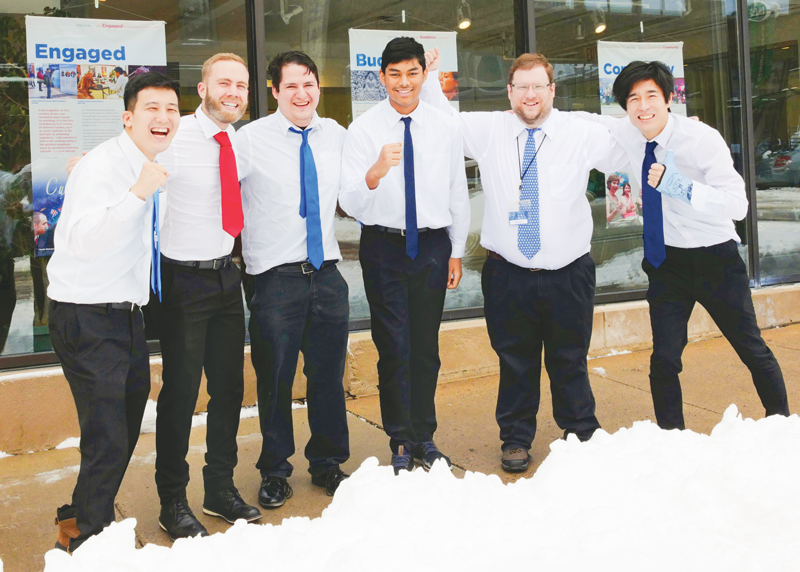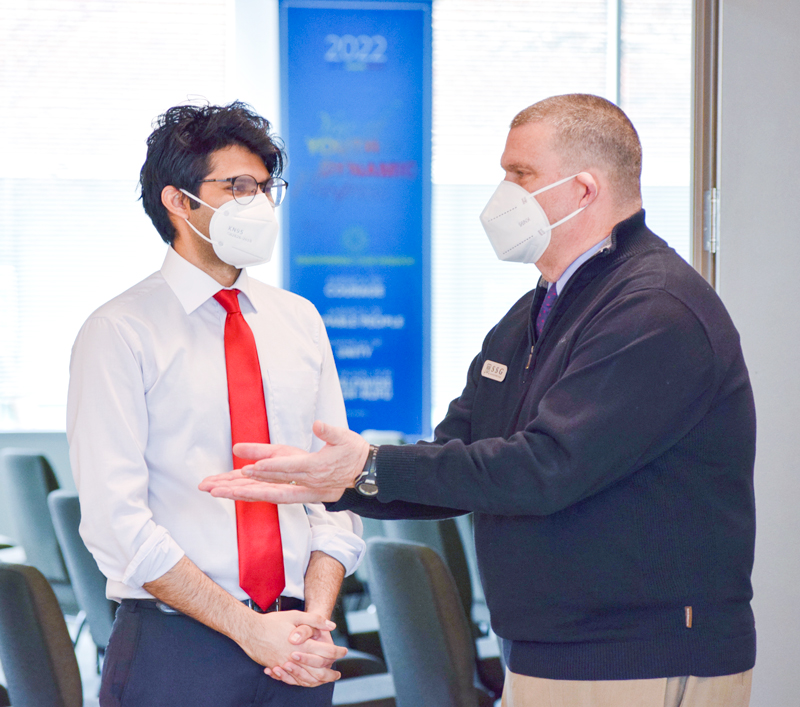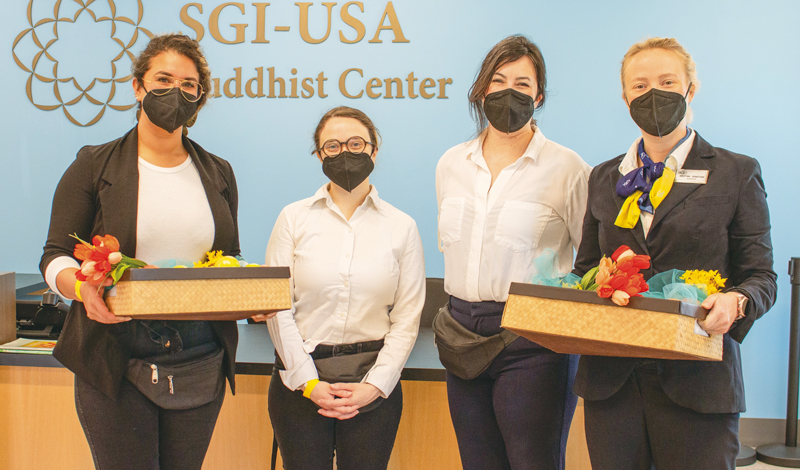“Youth have a mission to take the initiative to protect others. Without learning such lessons, egotism prevails and society is corrupted from its foundations. Training young people to serve society and the people is one of the major roles of the Soka Gakkai.”[1]
—Ikeda Sensei
Each time a Buddhist center opens for a meeting, a core group of youth are the first to arrive and the last to leave. Their mission: to ensure the safety and success of each activity in their mentor’s stead.
They are members of the Byakuren, Soka Group and Gajokai—behind-the-scenes training groups created by Ikeda Sensei to foster young people into future leaders who possess both the spirit and ability to serve humanity.
During their shifts, they learn invaluable skills, including clear and swift communication, thorough preparation, composure in difficult situations and vigilance to prevent accidents.
As Sensei states, “Working wholeheartedly behind the scenes to support kosen-rufu and protect the Soka Gakkai is a most noble form of Buddhist practice.”[2]
A year into the reopening of SGI-USA Buddhist Centers throughout the country, these groups have become an even more significant training ground for fostering Soka successors who will assume primary roles on the main stage of society and kosen-rufu in the future.
Representatives of the Byakuren, Soka Group and Gajokai shared with the World Tribune what they’ve learned through these training groups about serving the members and how this training has enabled them to win in their daily lives.
—Prepared by the World Tribune staff
Byakuren Group
As they clean,
their actions shine
with Buddhahood.[ref]Ibid. 119.[/ref]
On July 8, 1966, Ikeda Sensei announced the name “Byakuren Group” for the young women who took responsibility to greet the members and support the cleaning of the head temple grounds. Byakuren meaning “white lotus flower” conveyed the spirit of the members who “live in the corrupt and polluted world of the Latter Day of the Law, remain pure and unsullied by their surroundings.”[3] Today, Byakuren Group members support various activities behind the scenes with the spirit to protect and serve the members on behalf of Sensei.

Polishing My Life Through Byakuren
by Kimberly Cadillo
Elizabeth, N.J.
When I joined the Byakuren in 2017, I didn’t understand the spirit, so it felt like a chore. Naturally, I stopped participating. But during the pandemic, it became clear how much everyone needed the Buddhist center. I started to think about why Ikeda Sensei created the Byakuren Group, and I realized that, as a youth, it was time for me to stand up and take action for others. When the center reopened and I was asked to support, I said, “Yes, I’ll be there,” with the spirit to be there on behalf of Sensei.
Just as the members needed us, I needed Byakuren too. Through the training, I’ve learned how to carry myself with confidence and composure. By nature, I’m an anxious person, so if something doesn’t go my way, I used to freak out thinking that everything was ruined. But now I can stay calm and think about what I need to do to resolve the issue in the quickest and best possible way. Byakuren has helped me polish my life.
Everyone has problems, but on shift, we leave them at the door. We greet everyone with bright smiles and are ready to be there to support the members. The Buddhist center is a place for everyone to rejoice, talk to each other and connect with Sensei. No matter what we are going through, we smile and shine brightly everywhere like the sun.

Soka Group
A Soka Group member,
stands alone
in the cold wind.[4]
On Nov. 2, 1976, the Soka Group, which comprises young men who support Soka Gakkai event planning and operations, was renamed. It was originally established in October 1952 by second Soka Gakkai President Josei Toda as the Traffic Control Group, composed of young men overseeing the safe transport of members making pilgrimages to the head temple. At the first Soka Group General Meeting on Jan. 6, 1977, Ikeda Sensei stated: “The full mission of the Soka Group is to be the driving force for the advance of kosen-rufu, and to make the entire Soka Gakkai strong so that it will endure into the far-distant future.”[5]
The Great Benefit of Soka Group

all illustrations by NGEDIT_VECTOR / FIVERR
by Everton Carvalho
Baton Rouge, La.
Since I was little, my mother brought me to SGI activities in São Paulo. “You’re accumulating good fortune!” she would say. It wasn’t until I moved to West Virginia for school that I was on my own and questioned whether Buddhism was for me.
I struggled to get by, scraping together money for college fees. Things needed to change, so I decided: I need to build fortune.
My district was all spread out, and they held activities over teleconference, so I saved up for a phone to attend. For in-person activities, members drove three hours one way to pick me up. But I continued, building my fortune. By senior year, I had the money for my own car to make that drive myself.
In the YMD Academy, I learned about Ikeda Sensei’s incredible efforts to lead kosen-rufu through The New Human Revolution. I want to share Sensei’s spirit, and, as a Soka Group member, I can do just that.
So much preparation goes into a Soka Group movement. Have we considered every detail? What else can we do to ensure the members are comfortable?
Afterward, we can be confident that, because we did our best, members and guests could come to the center and hear the guidance they need to move forward.
When deciding on schools, I wanted to be close enough to an SGI-USA center to do more Soka Group shifts. After I moved to Baton Rouge last year, the New Orleans center reopened. That meant my commute was only an hour. I was ready to fight all out.
Gas prices are high, but now doing shifts every week, I get to help Sensei and hold down the fort here in Louisiana.
All of the guys doing shifts consistently are the ones standing up in their districts, at work, in their lives. We’re building camaraderie and evolving together, knowing that, because of the Soka Group, we’re accumulating fortune.

Gajokai
The Gajokai—
Because of you
our citadel of Soka
flourishes and triumphs
as we carry out kosen-rufu.[6]
On Feb. 1, 1971, the Gajokai—gajo meaning “fortress” and kai meaning “group”—was established for young men who support the security and operations of Soka Gakkai facilities, the fortresses of kosen-rufu. During an encounter with Gajokai members patrolling the perimeter of the Soka Gakkai headquarters, Sensei said: “I can’t go along with you on your rounds each time, but in my heart I’m always with you. We share the same mission. Please protect our headquarters in my stead. Protect our culture and community centers. Protect our members.”[7]

4 Ways Gajokai Changed My Life
by Dave Drake
New York
Relaxing evenings are something I enjoy with my partner, but when she became ill a couple years ago, those nights quickly changed. Often, she’d approach me, abruptly, saying, “I can’t breathe.”
There is no room for hesitation. I need to take her to the emergency room immediately. Fortunately, I was trained in the Gajokai. Boom—action begins.
The Gajokai has given me the conviction in faith and concrete training to be ready for any crucial moment.
I joined at the suggestion of young men I met at the New York Culture Center whom I admired, all Gajokai members. They were joyful, fighting for others and crushing it with actual proof of victory.
Gajokai has since completely changed my life. Allow me to share some examples!
Number one: Initiative! Gajokai teaches me to go above and beyond, especially in my career as a musician. Someone needs equipment gathered? They need to speak with venue staff or the rest of the band? Everyone parrots the same response: “Dave will take care of it.” That’s Gajokai training.
Number two: Life condition! Every Gajokai shift requires me, no matter my surroundings, to be solid and warm to others. Just as Ikeda Sensei teaches and those young men showed me, I resolve to never complain and, with my presence alone, put people at ease.
Number three: Capacity! Gajokai expands my limits. It’s easy to say, “I don’t have time.” But Sensei teaches us to master our time without sacrificing anything. Now I can win in rehearsal, my family, SGI activities and relationship—all in the same day.
Number four: Tangible benefit! I was prepared each time my partner needed me, and her health improved. Through Gajokai shifts, I developed discipline and built fortune, and after years of unstable housing, I secured the greatest apartment I’ve ever lived in!
Imagine if society was filled with people trained in the Gajokai. How awesome would that be?
You are reading {{ meterCount }} of {{ meterMax }} free premium articles

